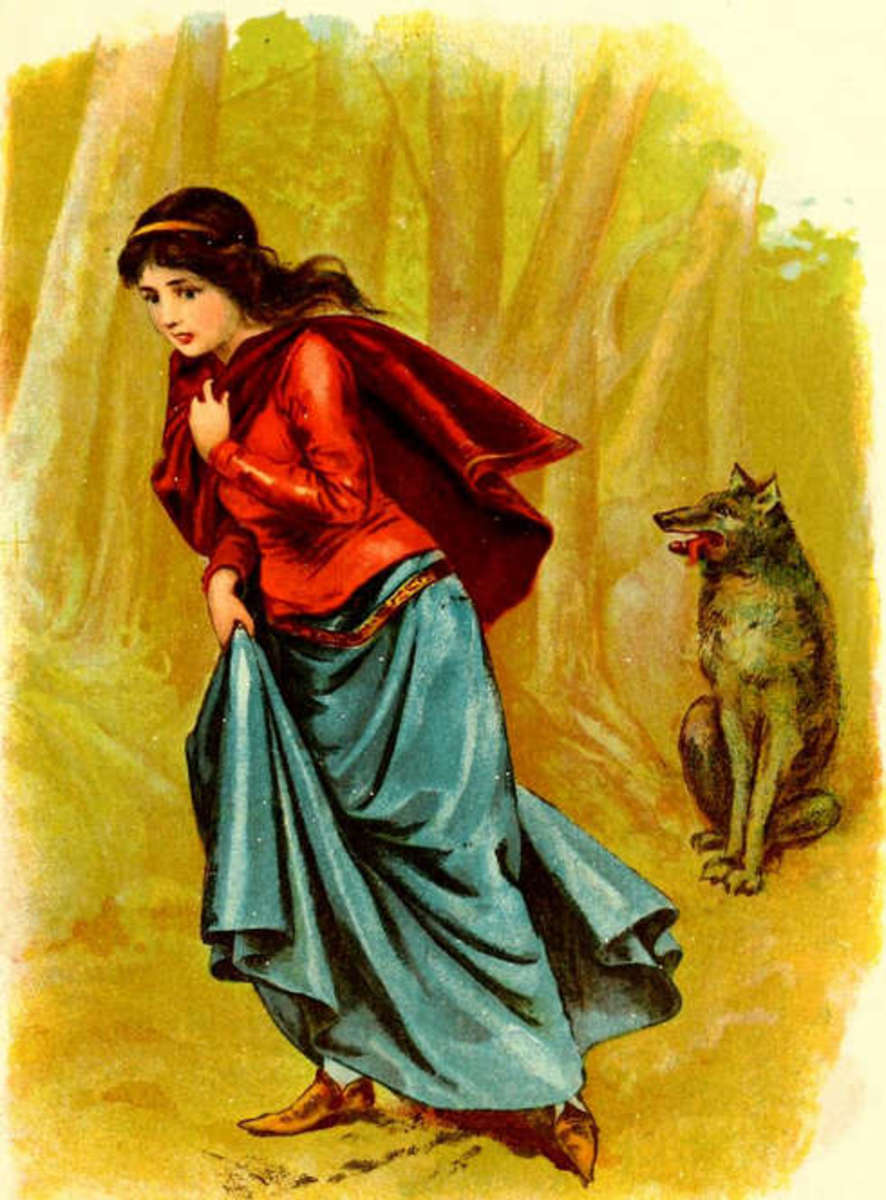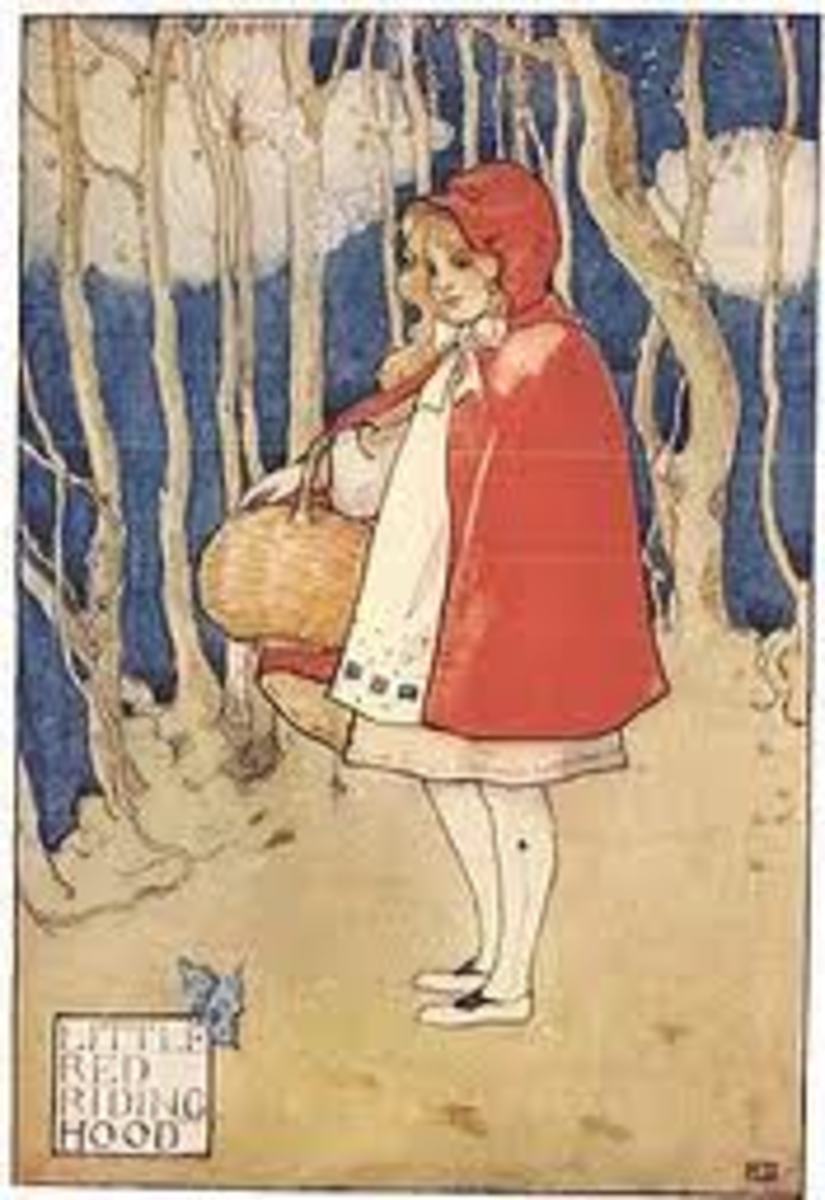Stalking - Its Motivation Obsession and Consequences
Tenderness can be a prelude to obsession

At what point does wooing become predatory?
Such sayings as “Faint heart never won fair lady” or “The course of true love never runs smooth” have sometimes served as self-justification for a level of pursuit which is now deemed stalking. Traditionally, girls were taught to play hard-to-get, based on the theory that her admirer might value her less if she seems too available.
In addition, men have believed, with some truth that many women wish to be chased; failure to pursue with adequate zeal may be perceived as a lack of genuine interest. This can create a conundrum; when does courting become coercion?
Indeed, a post-card sent a century ago by my great-grandfather to his wife, shows a silhouette of a couple in which the young lady is saying:
- “Don’t! Stop! Don’t. Stop.
- Don’t stop. Don’t stop!”
This same reticence as a veil for desire is voiced in the 1960s play/film ‘The Music Man’, when the male protagonist refers to “some dewy-eyed miss who keeps resisting, all the while she keeps insisting”.
Dilemma: Can it be right to be nearly wrong occasionally?
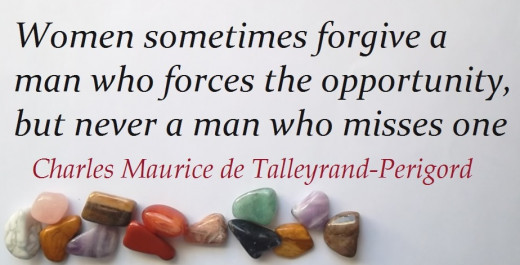
Initially the stalker maybe an overbearing acquaintance
Some years ago, I recall leaving a restaurant with Grace, a recent acquaintance. At one point, she stopped speaking mid-sentence, her glance drawn towards a youngish man who seemed about to approach her.
“Let’s hurry, OK?” she said, gripping my arm; then as he began to step into our path, sighed, “Dammit, too late.”
He proceeded to stride towards the restaurant door, not blocking our exit, but making it awkward for us to pass him without speaking.
“Hello, Grace the gorgeous,” he said, stepping forward, clearly wishing to kiss her.
“Hello, Bart,” she replied, with no joy. “My friend and I are leaving; we have a meeting to go to.”
“I’m leaving, too,” Bart said, and then added, “I just wanted to ask if you’ve been getting my emails. I’ve sent you a lot, but you have not answered even one of them.”
“I never have time to read them, “Grace said, “So it would be best for you not to send any more.”
Bart flinched, stiffened, his eyes fastening on her face as he said, “I will keep sending them anyway.”
At that point, he stepped aside enough to let us pass by, but kept his gaze planted on Grace until we were well outside the doorway.
When she was sure he could no longer hear, she said,
“I met that creep in a seminar last term. We went out for coffee twice, so when he asked for my email address, I found it hard to refuse. Now, he sends me emails two or three times a day, most of them love notes. I’ve thought of changing my email address, but that would involve letting everyone know-not only my long-time friends, but people I interact with on newsgroups and social networks.
I just wish I knew how to get rid of him. I feel caught in a rat trap.”
You may never escape the compulsion of the enemy within you

The truth in fairy-tales: Little Red Riding Hood was a victim
As Dr. Bruno Bettelheim illustrates in his book, The Uses of Enchantment, fairy-tales often encapsulate cores of wisdom and observations of human nature. Little Red Riding Hood contains two timeless lessons: heed parental warnings, and do not engage in conversations with strangers. The warnings conveyed in this story have roots going back to the 17th century and possibly before. According to the most widely-known version of this tale, written by Brothers Jacob and Wilhelm Grimm, a pubescent girl is dubbed Little Red Riding Hood due to her preferred mode of dress.
As her grandmother is ill, the girl’s mother asks her to bring her a basket of treats, but instructs her not to take a shortcut through a wooded area.
Choosing the swifter route, she is soon approached by a seemingly kindly wolf. When he asks where she is going, she tells him her destination. The wolf, in his guise as friendly adult, urges her to pick some wildflowers to add colors and fragrances to her basket. Young and trusting, she does as the wolf suggests - much to her sorrow. Believing the wolf to have gone on his way, she chooses flowers, enjoying the sun of the afternoon.
Gaining trust is part of the dastardly plan
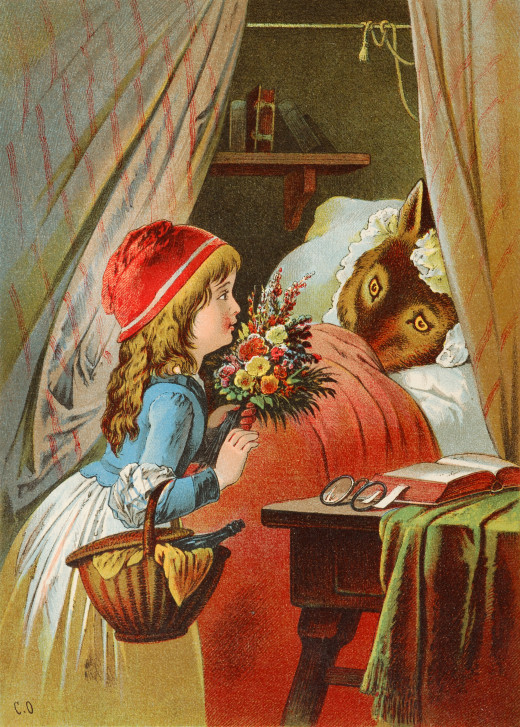
The big bad side of this wolf becomes activated
Like many stalkers, he has gained enough information to pounce on his victim /s.
After gaining entry to her grandmother’s home, he then swallows her in one gulp. Then, he lies in her sickbed, well-covered in quilts, awaiting Red Riding Hood’s visit.
When the girl reaches the house, the wolf deflects her questions about the enlargement of her grandmother’s ears and eyes by claiming these changes will better the ability to see and hear her.
When the girl notes the size of the teeth, the wolf growls,
- “The better to eat you with, my dear.”
And then proceeds to ingest her.
The softening of scary details
In the grimmer Grimm version, a woodcutter, hearing the pleas for help, opens the wolf’s belly, thus releasing both his victims intact. Children today are told the grandmother is merely locked in a closet, while Little Red Riding Hood enlists the help of a woodcutter to kill the intruder. Therefore, no real harm is done. Still, this tale contains all the elements of a characteristic stalking. Though generally happening over a longer time period, a typical stalker gains the trust of his prey, gathers enough information to track him or her, and then maximizes his use of this knowledge to force whatever advantage he seeks.
The struggle to verify stalking
The choice of the word “stalking” to describe the sinister pursuit of one person by another undoubtedly stemmed from the stalking of an animal, such as a deer or buffalo, by one or more hunters determined to bring it down. In this context, the hunter strives to conceal himself from his sought-after prey until the moment when success in its slaughter is all but assured. Conversely, the stalking of one human being by another is intended to harass and/or intimidate in ways both subtle and sinister.
- The consequences of tact and politeness
The act of stalking can be encapsulated as the unwanted, often continuous, contact between a perpetrator and victim. Still, this area remains oblique. In the above example of Grace and Bart, unless she indicates, in written form, her desire to sever his one-sided courtship, Bart has every legal right to claim she never found his ceaseless emails disquieting.
For many, the wish to avoid wounding someone’s pride or feelings over-rides the urge to become somewhat confrontational. Those like Grace often hope their lack of response will, eventually, serve as a deterrent; if nothing more, someone like Bart will get bored enough to seek out new contacts. While ideally this silence succeeds, it sometimes impels a frustrated wooer to widen his range and depth of pursuit.
Being shadowed can be harder to prove. Even written requests, CCTV, and legal restraining orders are of little use, so long as the stalker appears only those places where members of the public have every right to be: a food market, library, horse-riding stable-the list is infinite. Constant proximity to a victim can be said to occur via a series of coincidences.
Proof of pursuit by a stranger is even harder to verify. In one case, when one driver accused another of following her on a road, he protested he had believed her to be someone he knew, who he wished to say “hi” to. Throughout the ensuing argument, his insistence continued. Soon after, when she turned her gaze back to the road, he shot her, as he had intended to do, from the moment he spotted her and realized she was alone in her car.
Good and evil can co-exist within the same character

All the menacing money can buy: the rage of a rich man
When renowned author and lecturer Kate Brennan (pseudo name) entered into a relationship with a man she refers to as “Paul”, she felt a frisson of apprehension both within herself and from those who knew both of them. Still, given no concrete basis, she felt no genuine cause for alarm.
Like many psychopaths, Paul possessed an eerie ability to sense Kate’s most basic insecurities, and sought to assuage them. Paul did all those tender things lovers do, giving small presents at just the right times, while never demanding any intimacy for which Kate was not ready.
A relationship only in name
Although Kate and Paul stayed together for three years, in gradual but definite ways, Paul began to withdraw his affection. Things deteriorated to the point where, lying beside her in bed, he would say he felt absolutely no desire to touch her. At first, Kate did all she could to dismiss this aloofness as a difficult patch. In time, however, she felt forced to see the love between them had ended. Thus, she told Paul she needed to end their relationship. Given his voiced distaste for her, she assumed he would be relieved. She was wrong: a narcissist must not be rejected.
The long-range power of purse strings
In severing her shackles to Paul, Kate had done the unthinkable. Thus, she would need to be punished. An advantage of nearly all physical stalkers is their knowledge of a victim’s habits and schedule. Hence, Paul’s first acts of vengeance consisted of invasive actions such as entering her apartment when he knew she would not be there, then shifting her things about in a way which reminded her of his potential malevolence.
When she moved house, he began paying others to haunt her by placing themselves in her pathway. Countless examples can be summed up in one man’s standing behind her in a queue, taunting her with an ominous smile. As she was about to leave, he gripped her shoulder and said, “You and I don’t know each other, but I know someone who knows you very well.”
When escape is impossible
Given Paul’s affluence, he has been able to stalk his victim for more than fifteen years. Now, at age 58, Kate knows that however faraway she might flee, she is likely to be met by a face with a gloating smirk, accompanied by smarmy words, from one of Paul’s hirelings.
At a time in her life when she has every right to feel safe and settled, she must still fear the unexpected appearance of one of these phantoms.
The internet spider’s web
As many of us have found, the internet has created relationships, helped new friendships evolve, and facilitated re-connections with friends from the past. The downside of this freedom lurks in the ability to keep a stranglehold on obsessions. In the past, it was fairly easy to disentangle one’s self from a tie which had become irksome. Now, the internet can become an iron web which can prove all but impossible to elude.
The agony of the obsessed
Everyone has the right to decide to end a contact of any length or kind, romantic, professional, or platonic. Still, the flexibility of the internet can keep a laceration from healing. The balm of time can no longer quell the hope of reuniting one day, however far in the future.
Can hypnotherapy be a healer?
One woman, while on vacation, became involved with an Asian man. So deep was their shared devotion that he travelled with her back to America. There, they lived at her home for six months, until immigration laws forced him to return to his home country. Once back in his native land, the man renewed a previous relationship. Hence, he emailed his American lover to say both his mind and heart had changed, and he wished to end their liaison.
Sadly, she had believed them to have been on the edge of engagement, and that he planned to return to her the moment the laws allowed. After several email exchanges during which she entreated him to give their relationship one more go, he told her in definite terms to discontinue all contact. Still, she convinced herself there might be some aspect of their love which he might not have considered. Hence, she began text and emailing him a minimum of ten times a day, despite his continuing silence.
She realized that somehow she needed to end her obsession and feeling impelled to experiment, she decided to try hypnotherapy. While not everyone finds hypnotherapy fruitful, her eagerness to be relieved of this demoniac drive opened her subconscious mind to absorb the therapist’s suggestions. After that, to her amazement, she felt no more than the vaguest urge to contact the man.
A brief aftermath
She might have continued her progress, had the man not phoned her. As his tone was chatty and casual, she retained her serenity. Then, next day, he phoned her again, this time pleading for money in order to maintain his new family, claiming their first child was gravely ill. While refusing his plea, this cruel re-connecting restarted the flame which had by then paled to a flicker. Her texts and emails began once again, escalating upwards. Again she sought hypnotherapy, and became determined to refuse any further contact. Although no cure can be absolute, at this writing, she is beginning a new relationship, but in a more tentative way, her sense of trust having been tainted.
He feared not those who ambushed his righteous ambitions

The stalking of a man of peace: Dr. Martin Luther King’s assassination
We can sometimes feel a degree of empathy and compassion for those who, spurred by obsessive love, resort to aberrant behavior. While such perpetrators must be penalized, their behavior is often due to emotional pain which can be overwhelming.
Conversely, crimes motivated by malevolence towards a spokesperson of a movement or cause can generate complete loathing. Contempt is compounded when it becomes clear such an act was spurred by hopes of obtaining a place in history. James Earl Ray, killer of Dr. Martin Luther King Jr., admitted to both these incentives.
Who was James Earl Ray?
Born in 1928, by 1968, having reached age forty, he had accomplished nothing. He was, however, well-known to the judicial system as a habitual offender. His crimes consisted of burglaries, armed robberies, forgeries, and other fairly minor offenses. Still, in 1959, his record of repeated offending resulted in his being sentenced to twenty years in the Missouri State Penitentiary. In 1967, he escaped from this facility by concealing himself in a bread wagon.
James Earl Ray born March 10, 1928 to April 23 1998

“That’s how I'm going to go.”
Still, even if Ray had remained behind bars, so revered and powerful had Martin Luther King become, that he became convinced he would be brought down by an assassin. According to his widow, Coretta Scott king, having watched televised coverage of the 1963 killing of then President John F. Kennedy, King said, “That is how I am going to go.”
Finding his words beyond contradiction, all Mrs. King felt she could do was move closer to him and take his hand. She, too, had no choice but to accept the fact of his increasing danger. Acknowledging the jeopardy of his position, King kept few or no bodyguards, knowing if someone was determined to kill him, a phalanx of bodyguards could not halt the force of one well-aimed bullet.
Martin Luther King Jr., and his wife Coretta King
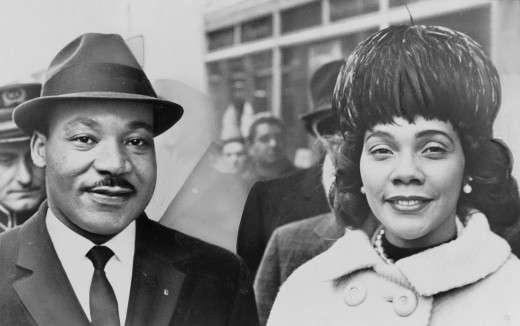
First signs of James Earl Ray’s rage against African-Americans
It will probably never be known why Ray’s inner life seems to have been suffused by a growing degree of hatred. Though his family was poor and somewhat dysfunctional, countless sufferers from such backgrounds become solid adults with respectable jobs and successful relationships. James Earl Ray, using a number of aliases, drifted about, earning or stealing just enough for basic subsistence. Forming no lasting bonds, his intimate contacts with women consisted largely of visits to massage parlors and such.
One prostitute, Manuela, began to date Ray. Towards the close of nearly every encounter, Ray would ask her to marry him. Although each time she declined, she continued to see him. Her decision to refuse him forever crystallized one night in a tavern. As the space between tables was slight, it was not unusual for patrons to brush against one another in passing.
At one point, an African-American man lightly jostled Manuela. Turning back, the man apologized in a genuine, dignified way. While Manuela was in no way offended, Ray leaped up and pounced on this man, giving him a powerful beating. At this time, in that area of America, such an appalling act was tolerated. After that, however, the aghast and disgusted Manuela put an end to their liaison.
James Earl Ray’s political discipleship of the racist George Wallace
Having no discernible focus or goals, Ray seems to have found a vent for his sense of nothingness in his advocacy of the views of George Wallace. Even as the civil rights movement gained strength and eminence, Wallace vaunted his racist, anti-integration views. Ray became such a devotee of Wallace’s policies as to volunteer to work in his headquarters when he campaigned for the 1968 presidency. Wallace’s virulence against various left-wing causes seems to have validated Ray’s quest for a target for those inner toxins which, long in abeyance, had begun to devour him.
George Corley Wallace Jr. Remembered for his racist political campaigns and racial rhetoric

Ray’s actions prior to the assassination
On March 5 1968, building a disguise, Ray underwent a Rhinoplasty, a cosmetic procedure to reshape his nose and make it appear less bulbous. He did not, however, keep the standard appointment during which a photograph is taken in order to show the difference made via the procedure.
On March 18 Ray began a journey in quest of Dr. King. While in Birmingham Alabama, he bought a powerful rifle with a telescopic sight and packs of bullets. When providing the required information at the time of purchase he gave a false name and said he needed the gun for a deer hunting trip. The sales person later recounted that the deer hunting season was over, and Ray’s knowledge of guns seemed far too vague for someone with genuine hunting experience.
The last days
While on his quest, Ray also acquired a transistor radio and a pair of binoculars. While staying in various flophouses, much of his time was deployed in reading newspapers, perhaps in hopes of tracking Martin Luther King’s itinerary. Dr. King was meant to give a speech in Memphis Tennessee on April 1, but instead rescheduled it for April 4. Meanwhile, having reached Memphis, Ray rented a room in a rooming-house, where several residents shared one bathroom.
Much to the annoyance of fellow sharers, Ray monopolized this bathroom on the afternoon of April 4. From its window, utilizing his newly acquired rifle, he shot Dr. King as he stood on the balcony of the Lorraine Motel, whilst he was chatting at ease with a few of his major supporters.
The greatest speech ever made by Robert F Kennedy announcing the death of Martin Luther King Jr.
Conclusion
It is, at this point in our legal and societal systems, impossible to find a concrete definition of stalking. Such attempts as have been made, in other areas, tend to include such words as unwelcome, excessive contact with another. Still, as this type of misconduct can take countless forms, whether or not it constitutes stalking must be judged on a case by case basis. While sending cards, chocolates or flowers may begin as a friendly or flirtatious gesture, if done too often, and after the sender has been asked to desist, they may evolve into acts of aggression.
Although a victim can seek legal actions for the offences of stalking and harassment; there can be no guarantee that any procedure will bring a definitive end to the outward signs of obsessive behavior.
Have you ever been victimized by any type of stalking?
Bibliography
-
Bettelheim, Bruno: The Uses of Enchantment: The Meaning and Importance of Fairy Tales: Publisher: Penguin 1991
- Brennan, Kate: In His Sights: A True Story of Love and Obsession: Publisher: Harper 2008
- Brothers Grimm: illustrated by Daniel Egneus: Little Red Riding Hood: Publisher: Harper Design 2011
- Carlo, Philip: The Night Stalker: The Life and Crimes of Richard Ramirez: Publisher: Kensington; New edition April 2006
- King, Dexter Scott & Ralph Wiley: Growing Up King: An Intimate Memoir: Publisher: Warner US; New edition May 2004
- Sides, Hampton: Hellhound on his Trail: The Stalking of Martin Luther King, Jr. and the International Hunt for His Assassin: Publisher: Penguin May 2011
© 2014 Colleen Swan


